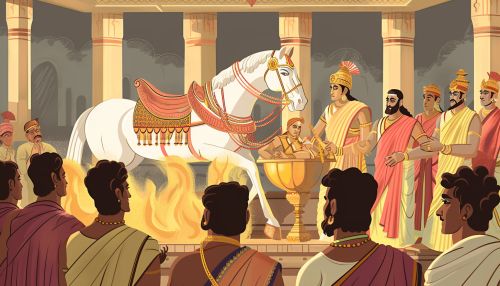Ashvamedha
Introduction
The Ashvamedha (Sanskrit: अश्वमेध, aśvamedhá) is an ancient Indian ritual of horse sacrifice that was performed by kings to assert their dominion and sovereignty over their realm. This Vedic ritual is detailed in the Yajurveda and has been referenced in various ancient Indian texts, including the Ramayana and the Mahabharata. The Ashvamedha is a complex and elaborate ceremony that involves numerous rites and rituals, and it holds significant historical, religious, and cultural importance.
Historical Context
The Ashvamedha ritual dates back to the Vedic period, which is estimated to be around 1500–500 BCE. It was primarily conducted by kings who sought to establish their supremacy and extend their territories. The ritual is mentioned in several ancient texts, including the Rigveda, Yajurveda, and the Brahmanas. The performance of the Ashvamedha was considered a mark of a powerful and prosperous ruler.
Ritual Procedure
The Ashvamedha ritual is an elaborate ceremony that spans over a year and involves several key stages:
Selection of the Horse
The ritual begins with the selection of a flawless horse, typically a white stallion. The horse is chosen for its strength, beauty, and purity, as it symbolizes the king's power and vitality.
Release and Roaming of the Horse
Once selected, the horse is released to roam freely for a year. It is accompanied by the king's warriors, who protect it and ensure that it is not captured or harmed. The horse's journey through various territories serves as a declaration of the king's dominion. Any ruler who challenges the horse's passage is considered to be challenging the king's authority.
Sacrifice and Offerings
At the end of the year, the horse is brought back to the capital, where it is ritually sacrificed. The sacrifice is conducted by the king's priests, who recite specific hymns and perform various offerings to the gods. The horse's body is then divided, and its parts are offered to different deities.


Feasting and Distribution of Gifts
Following the sacrifice, a grand feast is held, and gifts are distributed to the priests, warriors, and other participants. The feast symbolizes the king's generosity and the prosperity of his reign.
Symbolism and Significance
The Ashvamedha ritual holds deep symbolic meaning. The horse represents the king's power, vitality, and authority. The year-long journey of the horse signifies the king's dominion over his realm and his ability to protect and expand his territory. The sacrifice itself is a demonstration of the king's devotion to the gods and his commitment to upholding dharma (cosmic order).
References in Ancient Texts
The Ashvamedha is mentioned in several ancient Indian texts, each providing different perspectives on the ritual:
Ramayana
In the Ramayana, the Ashvamedha is performed by King Dasharatha, the father of Lord Rama, to obtain sons. The ritual is described in detail, highlighting its importance and the grandeur with which it was conducted.
Mahabharata
The Mahabharata also references the Ashvamedha, particularly in the context of King Yudhishthira's reign. After the Kurukshetra war, Yudhishthira performs the Ashvamedha to re-establish his authority and bring peace to his kingdom.
Vedic Texts
The Yajurveda and the Brahmanas provide detailed instructions on the performance of the Ashvamedha, including the selection of the horse, the hymns to be recited, and the specific offerings to be made.
Decline and Legacy
The practice of the Ashvamedha declined with the advent of Buddhism and Jainism, which opposed animal sacrifices. However, the ritual's legacy endures in Indian culture and literature. The Ashvamedha is often referenced in modern interpretations of ancient texts and continues to be a subject of scholarly study.
